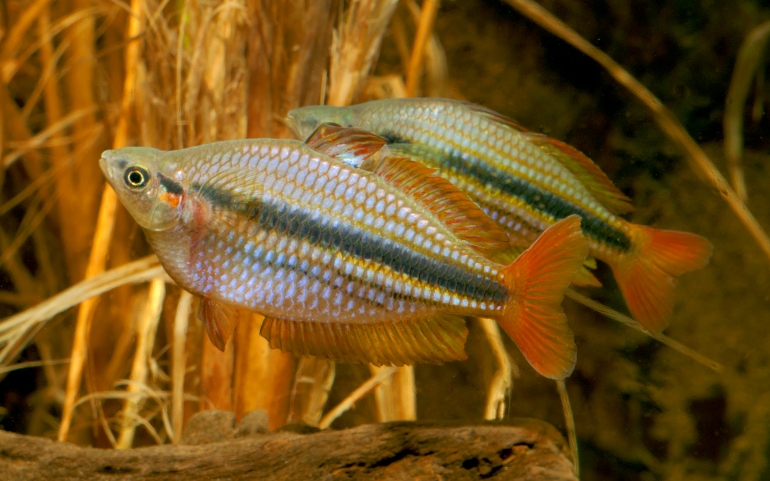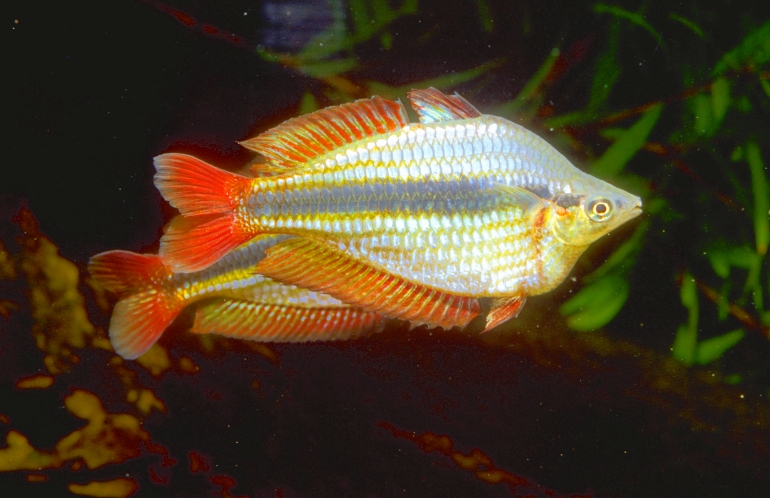|
 |
Melanotaenia sp. (Ferny Creek, NT) - photo© Gunther Schmida |
Taylor, 1964
Northern Rainbowfish
Species Summary
Melanotaenia solata was described by William R. Taylor in 1964 from specimens collected in 1948 from Groote Eylandt, Bickerton Island, and a creek near Yirrkala. The name "solata" is from solatus Latin, meaning sunburned. It is given to this species of rainbowfish in reference to the characteristic golden yellow life colours. Taylor described them as a species of Melanotaenia with a rather slender, compressed body; with complete dentition, with poorest developed in upper jaw; with a rather faint brown lateral body band and with numerous, characteristic, golden yellow life stripes through brown band as well as along the body. Large adults with diffuse dark band and about ten brilliant golden longitudinal stripes on each side; basal half of caudal fin bright yellow; bronze bar behind eye crossing preopercle and diffusing downward on opercle; belly and bases of second dorsal and anal fin pinkish; the inter-radial membranes paler outward; inter-radial membranes of first dorsal fin red. In specimens from Yirrkala, the dorsal and anal fins red; caudal fin yellowish orange; pelvic fins deep red; lower side bluish silvery; scale centres on side generally golden bronze; they form about five longitudinal rows, the lowermost of which is approximately on a level with the ventral surface of the caudal peduncle.
Following a scientific review of the rainbowfish family by Gerald R. Allen (1980) it was considered that Melanotaenia solata fell within the range of Nematocentris australis with regard to colour pattern, morphometrics and meristics, and in this review these two species were considered as one and were placed in the large "splendida" group as a sub-species, and named Melanotaenia splendida australis. However, earlier Allen (1978) remarked that Melanotaenia australis and Melanotaenia splendida inornata were so closely related that he was tempted to consider the latter a subspecies of M. australis. Morphologically or meristically there is little that tells them apart, the biggest difference is that Melanotaenia splendida inornata tends to be deeper bodied and seems to grow a little larger. Later, Allen et al. (2002) distinguished Melanotaenia australis and Melanotaenia solata on the basis of the genetic results of McGuigan et al. (2000).
"The differentiation of M. s. australis lineages in this study could (i) indicate the presence of two distinct species, (ii) be the result of introgression of the Northern Territory population with sympatric M. nigrans or M. exquisita, or (iii) reflect retention of ancestral polymorphisms. This third possibility is unlikely because the polymorphisms would need to be present in the ancestor of clades A, B and C. To distinguish between hypotheses (i) and (ii), M. s. australis, M. nigrans and M. exquisita would need to be characterised molecularly (mtDNA and nuclear) and morphologically from across their geographical range. This would also help to determine the cause of the polyphyly in cytochrome b of Northern Territory M. s. australis. If hypothesis (i) is true, then the name M. solata (Taylor 1964) could be applied to the Northern Territory populations following re-description. Irrespective of the situation in the Northern Territory, West Australian populations of M. s. australis should be accorded species status." ~ McGuigan et al. (2000).
"However, the status of M. solata is questionable based primarily on the mtDNA analysis of the unusual population from the upper South Alligator River which is introgressed with M. nigrans (Zhu et al., 1994; McGuigan et al., 2000). Therefore, it is probably better recognised as a synonym of M. s. inornata until further work is conducted, especially given the recognition that hybridisation may be the cause of at least some of the odd morphotypes observed." ~ P. J. Unmack 2009, pers. comm.
"Aside from the populations we visited, there are other unusual "inornata" populations in the Northern Territory that are worthy of discussion. These include fish sometimes referred to as Melanotaenia australis and/or M. solata (which is presently synonymised under M. splendida inornata). This was described from specimens collected in 1948 from Groote Eylandt, Bickerton Island (next to Groote), and a creek near Yirrkala. It is difficult to ascertain much from the original description except these populations had red fins which is atypical for M. s. inornata in that region. There was a more recent collection from Yirrkala of a red finned fish that appeared more like M. s. splendida than M. s. inornata according to Neil Armstrong. Whether this is the same fish as M. solata is unclear. Another form sometimes referred to as M. australis or M. solata is the red-finned fish from the upper South Alligator River. As mentioned previously, this form appears to be a hybrid with M. exquisita which may partially explain their odd appearance. The ultimate identity of M. solata populations remains a mystery, and will likely continue given the difficulty of collecting additional samples." ~ Unmack (2002).
Distribution & Habitat
Melanotaenia solata has been reported from several localities east of Darwin, including the upper South Alligator River and Yirrkala, Groote Eylandt, and Bickerton Island.
 |
The image above show some of my "Ferny Creek" population that were bred from fish originally collected in 1994. They are full-grown adults at about 3-4 years of age. - photo© Gunther Schmida |
Remarks
From what I can ascertain, two rainbowfishes, M. nigrans and M. splendida (solata?) were collected from the Emerald River, about 3.5 miles above the river mouth on Groote Eylandt in 1948 (Blaber et al. 1992). Rainbowfishes so far collected by ANGFA members from Yirrkala only include M. trifasciata and M. splendida inornata. However, another rainbowfish fitting the description by Allen et al. (2002) of M. solata was reported in the Howard River system near Darwin (Pidgeon, 2003). In the aquarium hobby rainbowfishes from the Blackmore River in the Northern Territory and Kambolgie Creek in the South Alligator River system are also often called M. solata. However, the fish known in the aquarium hobby as "Kambolgie Creek" actually comes from Ferny Creek. The rainbowfishes reportedly collected from Kambolgie Creek are the "standard" M. splendida inornata form (Gunther Schmida; Dave Wilson pers. comm., 2010). Nevertheless, species composition in a given habitat can vary from season to season, and from year to year.
Colour variability in rainbowfishes has been a source of confusion to both aquarists and biologists studying their life history. Populations of almost every river system they occupy have their own distinctive body colour and pattern. This colour variability is often related to habitat conditions. Colour can also vary considerably between upstream and downstream populations in the same river system. Particularly where there are waterfall barriers which prevent the natural dispersal of fish.
Despite the research that has been undertaken to date, the specific status and distribution of Melanotaenia solata still remains unclear. Consequently, until more scientific research has been completed on the M. solata complex, specific names based on the locality where each variety is found is best used by rainbowfish enthusiasts to identify the different varieties.
Literature
Allen G.R. (1978) The rainbow fishes of northwestern Australia (Family Melanotaeniidae). Tropical Fish Hobbyist 26: 91-102.
Allen G.R. (1980) A generic classification of the rainbowfishes (Family Melanotaeniidae). Records of the Western Australian Museum 8, 449-490.
Allen G.R., S.H. Midgley and M. Allen (2002). Field Guide to the Freshwater Fishes of Australia. Western Australian Museum.
Blaber S.J.M., D.T. Brewer and J.P. Salini (1992) A checklist of the fishes of Groote Eylandt, north-western Gulf of Carpentaria. CSIRO Marine Laboratories Report 218.
Bishop K.A., S.A. Allen, D.A. Pollard and M.G. Cook (2001) Ecological studies on the freshwater fishes of the Alligator Rivers Region, Northern Territory: Autecology. Supervising Scientist Report 145, Supervising Scientist, Darwin.
McGuigan K., D. Zhu, G.R. Allen and C. Moritz (2000) Phylogenetic relationships and historical biogeography of melanotaeniid fishes in Australia and New Guinea. Maine and Freshwater Research, 51: 713-23.
Pidgeon R. (2003) A review of options for monitoring freshwater fish biodiversity in the Darwin Harbour catchment. A report prepared for the Water Monitoring Branch. Environmental Research Institute of the Supervising Scientist, Darwin.
Taylor W. R. (1964) The fishes of Arnhem Land. In 'Records of the American-Australian Scientific Expedition to Arnhem Land.' (Ed. R. L. Specht.) pp. 44-307. Melbourne University Press: Melbourne.
Unmack P.J. (2002) Darwin Rainbows. Fishes of Sahul 16(3): 858-861
Zhu D., B.G.M. Jamieson, A. Hugall and C. Moritz (1994) Sequence evolution and phylogenetic signal in control-region cytochrome b sequences of rainbowfishes (Melanotaeniidae). Molecular Biology and Evolution 11: 672-683.
Adrian R. Tappin
Updated January, 2011



|

